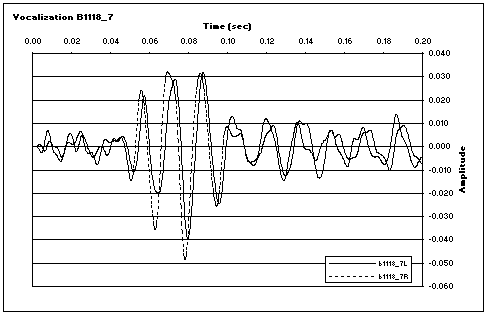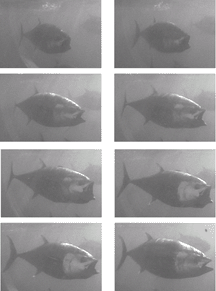Workshop Proceedings: Short Papers
Detection and characterization of yellowfin and bluefin tuna using passive acoustical techniques
Scott Allen, Scripps Institution of Oceanography (allen@sdsioa.ucsd.edu)
David A. Demer, NOAA/NMFS/SWFSC/Fisheries Resources Division, 8604
La Jolla Shores Drive, La Jolla, CA 92037 (david.demer@noaa.gov)
Introduction
Underwater sounds generated by Thunnus albacares and Thunnus thynnus were recorded and studied to explore the possibility of passive-acoustical detection. Tuna vocalizations were recorded at the Monterey Bay Aquarium, Monterey, California, and Maricultura del Norte in Ensensada, Baja California, Mexico. At both locations, the most prevalent sounds associated with tuna were low-frequency pulses varying from 20 to 130 Hz, lasting about 0.1 seconds, and usually single and unanswered (Fig. 1). A behavior similar to coughing was coincident with these sounds: the animal's mouth opened wide with its jaw bones extended and its abdomen expanded, then contracted abruptly. On one occasion in Mexico, this behavior and associated noise were simultaneously recorded (Fig. 2). The center frequencies of these vocalizations may vary as the resonant frequencies of the tuna's swim bladder, suggesting a passive-acoustical proxy for measuring the size of tuna. Matched-filter and phase-difference techniques were explored as means for automating the detection and bearing-estimation processes.
 |
| Figure 1. Bluefin vocalization recorded at Maricultura del Norte, 18 November 2000 using two hydrophones (a) and their power spectral densities (b). Signals were low-pass filtered (Order 4 Butterworth, fc=600 Hz). Estimated sound pressure level is 105 dB re 1 mP. |
 |
| Figure 2. A bluefin tuna vocalizing at Maricultura del Norte Ensenada. During the vocalization, the animal's mouth opened wide with its jaw bones extended and its abdomen expanded, then contracted abruptly. |
Conclusion
This study shows that adult bluefin and yellowfin tuna, like many other fish, are capable of generating sound. The acoustical signals are short (~0.1 s), narrow-bandwidth pulses of low frequency (20-130 Hz) and amplitude (~105 dB re 1 mPa @ 1m).
Observations of these fish suggest that a coughing or yawning behavior causes muscular contraction about the swim bladder and an associated short-duration sound pulse of narrow-bandwidth and low-frequency and intensity. If the recorded sounds are generated by swim bladder resonance, then the size of the swim bladder determines the center frequency of the sound pulse. It is unknown whether the tuna vocalizations are generated as a by-product of some biological function such as clearing the gills, or an intentional form of communication.
Acknowledgements
We are thankful to Dr. Rennie Holt, Director of the United States Antarctic Marine Living Resources Program and Dr. John Hunter, Head of the Fisheries Resources Division, SWFSC, for providing the laboratory and equipment resources necessary to complete this study. We would also like to thank Dr. Kenneth Baldwin of the University of New Hampshire Center for Ocean Engineering for allowing S. Allen to conduct his Master's Thesis research at SWFSC. Thanks also to Mr. Ted Dunn, founder of Maricultura Del Norte of Ensenada, Mexico for graciously supporting this effort with access to his fish pens. Thanks finally to Dr. Charles Farwell, the manager of pelagic displays at the Monterey Bay Aquarium in Monterey, California.